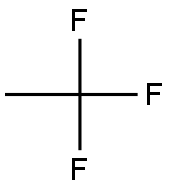1,1,1-트라이플루오로에테인(1,1,1-트리플루오르에탄) C화학적 특성, 용도, 생산
화학적 성질
1,1,1-Trifluoroethane is a colorless gas or a
liquid under pressure.
용도
HFC 143a is used as a refrigerant and as a component in some
refrigerant blends.
일반 설명
1.1.1-Trifluoroethane is a colorless, highly flammable gas. 1,1,1-Trifluoroethane is heavier than air and vapors may travel from a leaking container to a source of ignition causing a flame to flashback to the container. Contact with the unconfined liquid can cause frostbite. Under prolonged exposure to fire or heat the containers may rupture violently and rocket.
공기와 물의 반응
Highly flammable.
반응 프로필
Halogenated aliphatic compounds, such as 1,1,1-Trifluoroethane, are moderately or very reactive. Reactivity generally decreases with increased degree of substitution of halogen for hydrogen atoms. Low molecular weight haloalkanes are highly flammable and can react with some metals to form dangerous products. Materials in this group are incompatible with strong oxidizing and reducing agents. Also, they are incompatible with many amines, nitrides, azo/diazo compounds, alkali metals, and epoxides.
건강위험
Vapors may cause dizziness or asphyxiation without warning. Some may be irritating if inhaled at high concentrations. Contact with gas or liquefied gas may cause burns, severe injury and/or frostbite. Fire may produce irritating and/or toxic gases.
화재위험
EXTREMELY FLAMMABLE. Will be easily ignited by heat, sparks or flames. Will form explosive mixtures with air. Vapors from liquefied gas are initially heavier than air and spread along ground. CAUTION: Hydrogen (UN1049), Deuterium (UN1957), Hydrogen, refrigerated liquid (UN1966) and Methane (UN1971) are lighter than air and will rise. Hydrogen and Deuterium fires are difficult to detect since they burn with an invisible flame. Use an alternate method of detection (thermal camera, broom handle, etc.) Vapors may travel to source of ignition and flash back. Cylinders exposed to fire may vent and release flammable gas through pressure relief devices. Containers may explode when heated. Ruptured cylinders may rocket.
Safety Profile
Mutation data reported. Whenheated to decomposition it emits toxic vapors of F??.
잠재적 노출
The 1,1,1-isomer is used to make
other chemicals and used as a refrigerant.
운송 방법
UN2035 1,1,1-Trifluoroethane, compressed or
Refrigerant gas, R 143a, Hazard Class: 2.1; Labels: 2.1-
Flammable gas. Cylinders must be transported in a secure
upright position, in a well-ventilated truck. Protect cylinder
and labels from physical damage. The owner of the compressed
gas cylinder is the only entity allowed by federal
law (49CFR) to transport and refill them. It is a violation
of transportation regulations to refill compressed gas cylinders
without the express written permission of the owner.
비 호환성
1,1,1-Trifluoroethane forms an explosive
mixture with air. Low molecular weight haloalkanes are
highly flammable and can react with some metals to form
dangerous products. Materials in this group are incompatible
with oxidizers (chlorates, nitrates, peroxides, permanganates,
perchlorates, chlorine, bromine, fluorine, etc.) and
reducing agents such as hydrides, nitrides, alkali metals,
and sulfides. Also, they are incompatible with many
amines, nitrides, azo/diazo compounds, alkali metals, and
epoxides.
폐기물 처리
Return refillable compressed
gas cylinders to supplier. Nonrefillable cylinders should be
disposed of in accordance with local, state and federal regulations.
Allow remaining gas to vent slowly into atmosphere
in an unconfined area or exhaust hood. Refillabletype
cylinders should be returned to original supplier with
any valve caps and outlet plugs secured and valve protection
caps in place.
1,1,1-트라이플루오로에테인(1,1,1-트리플루오르에탄) 준비 용품 및 원자재
원자재
준비 용품









